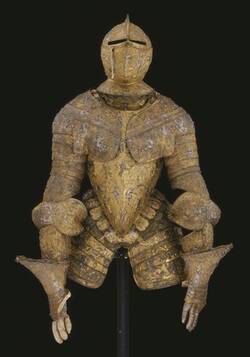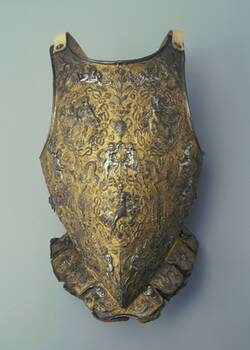The ceremonial armour you see here was originally not only gilded and covered with raised figures, symbols and foliage, it was even decorated with coloured enamels. The inventory of 1615 includes the following entry: “A beautiful gilded cuirasse of embossed metal with all kinds of beautiful, raised, coloured pictures and fruits. . .”
It seems that there were still traces of enamelled decorations in 1973. But although these coloured decorations have completely disappeared by now, the amour is still magnificent.
The armour, which includes a second, interchangeable breastplate, was a present: once again, for Elector Christian I. This time the present came not from a member of his own family but from the Italian Duke Carlo Emanuele I of Savoy. The gift of this precious armour was intended to cement the good relations that already existed between the House of Savoy and the princes of Saxony. It must have caused a sensation when it arrived in Dresden in 1588.
In terms of its design, this armour is suitable for both tilting and foot-tourneys. But it’s hardly likely that Christian I ever thought of wearing it in tournaments. It looks very splendid, but would not have served him well in a joust. On the inside you can see that numerous small holes have been beaten into the metal plate in the process of raising certain motifs as high as possible. This armour was clearly meant to be worn for ceremonial purposes.
The name of the armourer, or rather the goldsmith, who fashioned this suit of armour is not known to us. But the craftsmanship suggests that it was made in a French workshop. It is generally taken to be a wedding present for Emanuele Philiberto of Savoy, who married Margaret of France, the youngest daughter of the late King Francis I, in 1559. That would explain its French provenance.
The lovers’ knots with which the harness is strewn are also an indication that this was originally a wedding gift. If you look closely, you’ll see the little cord bows that frame the individual figures. They are decorated with blossoms and serve the frolicking cherubs as ladders and platforms. These knots symbolised the House of Savoy in Italian heraldry. Carlo Emanuele, who sent the armour to Elector Christian I in Dresden, was the son of Emanuele Philiberto and Margaret.

